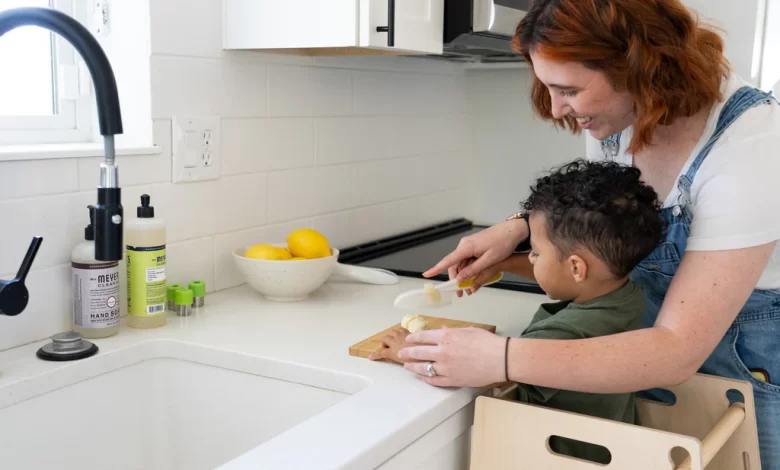Learning Tower Safety: The Essential Guide for Parents

Learning towers have become a beloved tool for families looking to engage their toddlers in daily tasks, especially in the kitchen. With their sturdy design and child-friendly height, learning towers make it possible for young children to safely reach countertops, enabling them to participate in food preparation and other hands-on activities. However, while these tools encourage independence and learning, they require some essential safety considerations. In this guide, we’ll walk through safety guidelines for setting up and using a learning tower in your home, along with tips to help your toddler develop safe habits from the start.
Setting Up a Safe Learning Tower Area
A learning tower is only as safe as the environment it’s placed in. When choosing where to position a learning tower in the kitchen, it’s essential to consider both stability and accessibility. For example, avoid placing the tower near hot surfaces such as the stove or any sharp utensils, as toddlers may reach out impulsively. Ideally, find a workspace near a corner or an area where the child has room to stand comfortably without being in the way of your cooking.
Additionally, ensure the learning tower is placed on a level, non-slip surface. Most quality learning towers come with anti-slip rubber feet or a stable base, but it’s still wise to double-check that it won’t slide on tiled or wooden floors. If necessary, place a non-slip mat under the learning tower for added security. For families who have multiple children, remind older siblings not to climb or lean on the learning tower while a younger child is using it, as extra weight or movement can increase the risk of tipping.
When setting up the learning tower, confirm that it’s locked or fully assembled as instructed by the manufacturer. Different designs have various locking mechanisms, and ensuring that all parts are secure can prevent unexpected collapses or wobbles. Many options in Montessori toys Australia offer durable learning towers made of high-quality materials like wood, which provide stability and align with Montessori principles of using natural, child-friendly materials.
Teaching Your Toddler Safe Learning Tower Habits
Once you’ve established a safe setup, it’s time to introduce your child to their new learning tower. For toddlers, the first few uses of any new item often involve curiosity and excitement, so taking a calm, guided approach can help set a safe tone from the beginning.
Start by modeling how to climb in and out of the learning tower safely. Show them where to hold on as they enter and exit, encouraging them to take their time and move carefully. Many parents find it helpful to stay beside their toddler for the first few uses, giving them guidance as they become accustomed to the tower. Reinforce simple phrases like “one hand on the side” or “two feet on the platform” to make the learning process fun and easy to remember.
As your child becomes more familiar with the learning tower, you can start to establish some ground rules for when they are using it. For example, let them know that the tower is only for standing (not climbing or sitting) and that they must always ask an adult before using it. Consistent reminders will help them develop safe habits that can prevent accidents.
Practical Tips for Safety in Action
A learning tower is often a child’s first real introduction to participating in kitchen activities, so taking a step-by-step approach can keep them both engaged and safe. Here are some practical safety tips to consider when using the learning tower for specific activities.
1. Cooking and Food Preparation
If your child is joining you for cooking activities, give them child-safe tools and assign simple tasks like stirring, washing, or adding ingredients. Montessori toys Australia has options for child-safe kitchen sets that include age-appropriate utensils, helping your child safely engage in cooking. Avoid activities that involve sharp knives or direct contact with hot surfaces. For example, while you’re cooking at the stove, you can set up a separate station with simple ingredients for them to mix and explore.
2. Cleaning and Practical Life Skills
The learning tower is also a fantastic tool for teaching practical life skills such as washing dishes or wiping the counter. Provide child-friendly sponges or a small dish for washing, which allows your toddler to help without direct access to potentially dangerous cleaning products or hot water. Setting up a mini task area in the learning tower helps children feel like active participants while staying safe.
3. Crafting and Non-Food Activities
When the kitchen isn’t in use, you can repurpose the learning tower for activities like crafting, drawing, or simple experiments. Placing a tray on the countertop and giving your child washable markers or play dough can turn the learning tower into a versatile activity station. These non-food activities allow children to practice fine motor skills and creativity without the risks associated with cooking.
Maintaining the Learning Tower for Long-Term Safety
Regularly checking your learning tower for stability and wear is essential for long-term safety. Look for signs of any loose screws, cracks, or unstable parts. A well-maintained tower is likely to last longer and will be safe for years, especially if you’re using it daily in a bustling kitchen environment.
Montessori-inspired designs, including learning towers and Montessori climbing frame, are crafted to be both durable and aesthetically pleasing, blending into home settings with ease. For Australian families, many high-quality learning towers can be found from local providers specializing in Montessori toys Australia.
Learning Tower Alternatives and Additions
Beyond the learning tower, other Montessori equipment can help create a dynamic and engaging environment for your toddler. A Montessori climbing frame or climbing triangle can complement the skills learned on the learning tower by encouraging balance, coordination, and spatial awareness. Setting up a safe climbing area in another part of the home gives your child additional opportunities to develop their gross motor skills while introducing variety to their daily play.
Concluding Thoughts on Learning Tower Safety
Learning towers offer a wonderful way for toddlers to engage in hands-on activities and develop practical life skills under adult supervision. By setting up a secure, non-slip environment and guiding your child in safe usage from the beginning, you can make the most of this Montessori-inspired tool while ensuring peace of mind.
Remember, building safe habits with a learning tower is a process that takes time and consistency. The more you model and reinforce safe practices, the more naturally they’ll become part of your child’s routine. Involving toddlers in daily activities promotes independence and confidence, aligning beautifully with Montessori principles.
If you’re considering a learning tower, Montessori toys Australia offers many durable and child-friendly options, allowing you to create an enriching, safe environment tailored to your child’s developmental needs. Whether you’re using it for cooking, cleaning, or crafting, a learning tower opens doors for your toddler to learn by doing—safely and joyfully.


